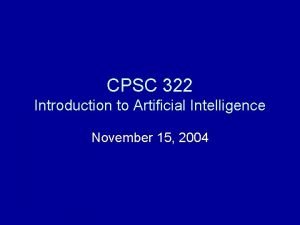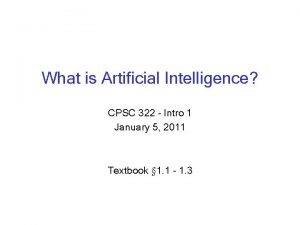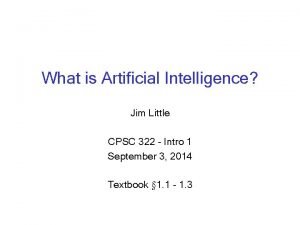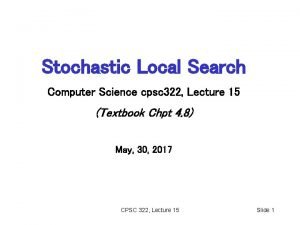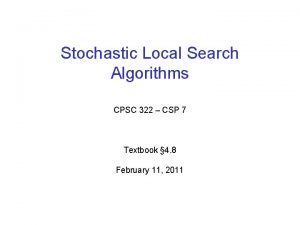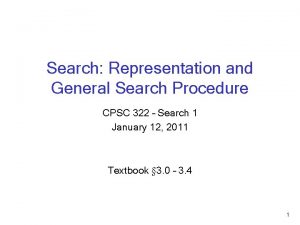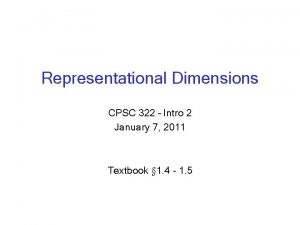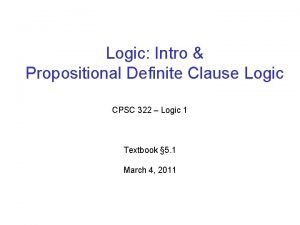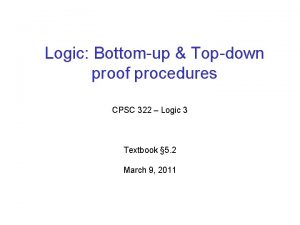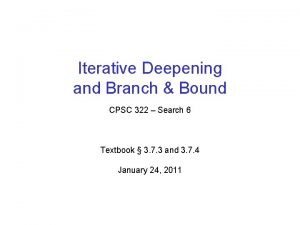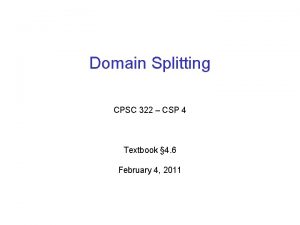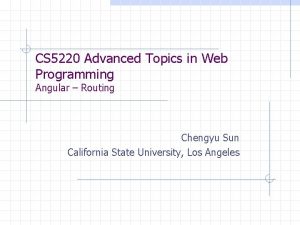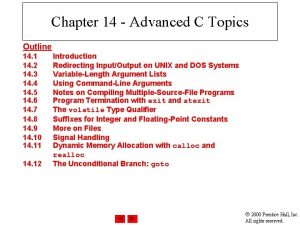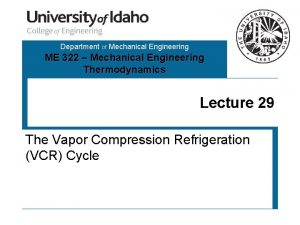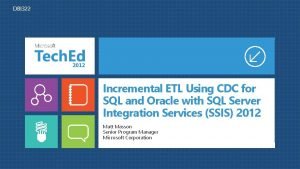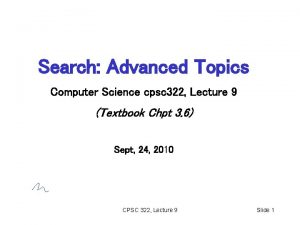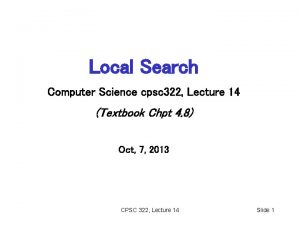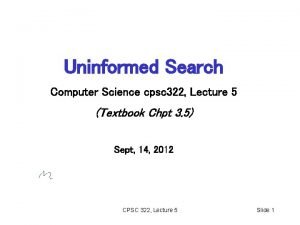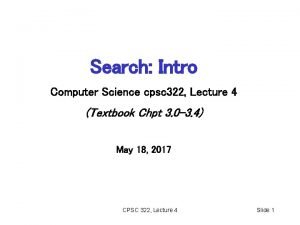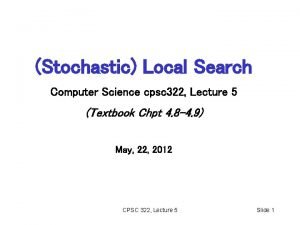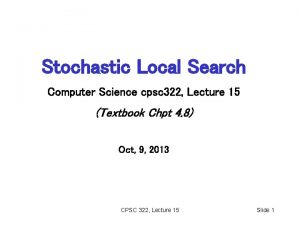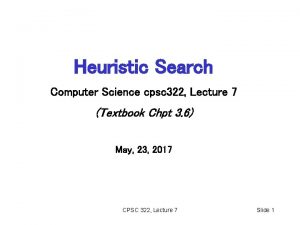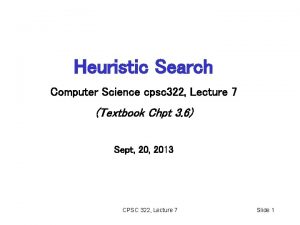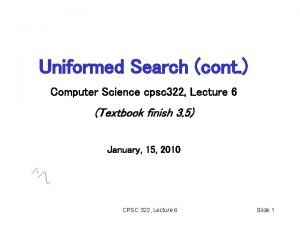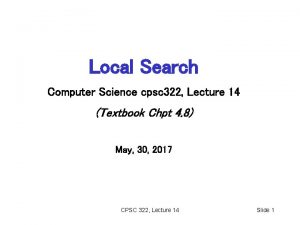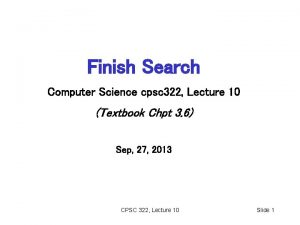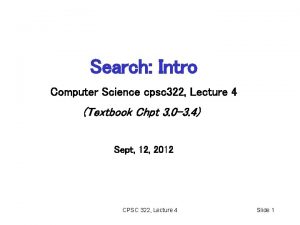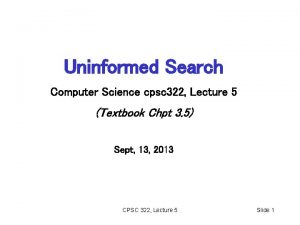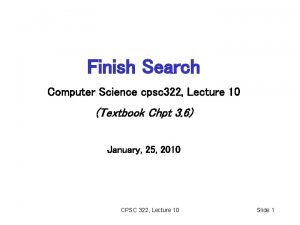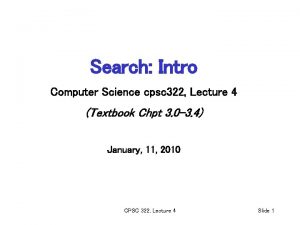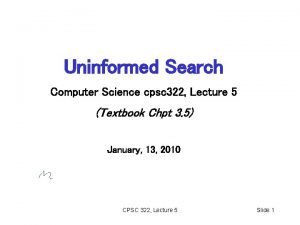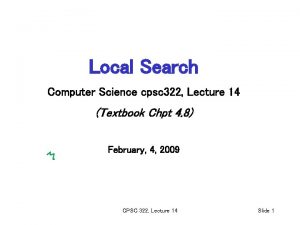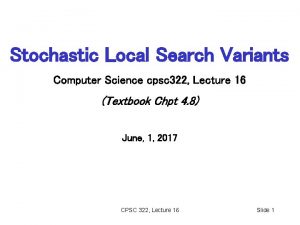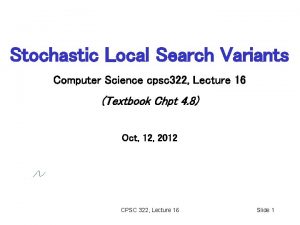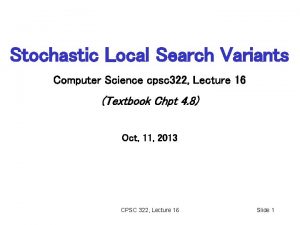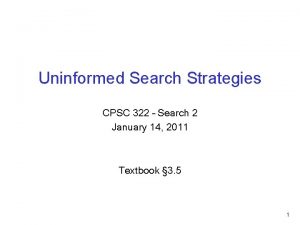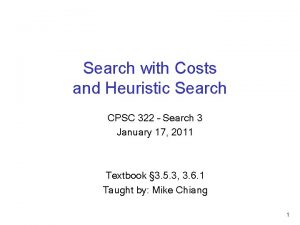Search Advanced Topics Computer Science cpsc 322 Lecture


























- Slides: 26

Search: Advanced Topics Computer Science cpsc 322, Lecture 9 (Textbook Chpt 3. 6) January, 23, 2009 CPSC 322, Lecture 9 Slide 1

Lecture Overview • • • Recap A* A* Optimal Efficiency Branch & Bound A* tricks Other Pruning Dynamic Programming CPSC 322, Lecture 9 Slide 2

Optimal efficiency of A* • In fact, we can prove something even stronger about A*: in a sense (given the particular heuristic that is available) no search algorithm could do better! • Optimal Efficiency: Among all optimal algorithms that start from the same start node and use the same heuristic h, A* expands the minimal number of paths. CPSC 322, Lecture 8 Slide 3

Why is A* optimally efficient? Theorem: A* is optimally efficient. • Let f* be the cost of the shortest path to a goal. • Consider any algorithm A' • • • the same start node as A* , uses the same heuristic fails to expand some path p' expanded by A* , for which f(p') < f*. • Assume that A' is optimal. CPSC 322, Lecture 9 p' p Slide 4

Why is A* optimally efficient? (cont’) • Consider a different search problem • identical to the original • on which h returns the same estimate for each path • except that p' has a child path p'' which is a goal node, and the true cost of the path to p'' is f(p'). • that is, the edge from p' to p'' has a cost of h(p'): the heuristic is exactly right about the cost of getting from p' to a goal. p' p'' CPSC 322, Lecture 9 p Slide 5

Why is A* optimally efficient? (cont’) • A' would behave identically on this new problem. • The only difference between the new problem and the original problem is beyond path p', which A' does not expand. • Cost of the path to p'' is lower than cost of the path found by A'. p' p p'' • This violates our assumption that A' is optimal. CPSC 322, Lecture 9 Slide 6

Lecture Overview • • • Recap A* A* Optimal Efficiency Branch & Bound A* tricks Other Pruning Dynamic Programming CPSC 322, Lecture 9 Slide 7

Branch-and-Bound Search • What is the biggest advantage of A*? • What is the biggest problem with A*? • Possible Solution: CPSC 322, Lecture 9 Slide 8

Branch-and-Bound Search Algorithm • Follow exactly the same search path as depth-first search • treat the frontier as a stack: expand the most-recently added path first • the order in which neighbors are expanded can be governed by some arbitrary node-ordering heuristic CPSC 322, Lecture 9 Slide 9

Branch-and-Bound Search Algorithm • Keep track of a lower bound and upper bound on solution cost at each path • lower bound: LB(p) = f(p) = cost(p) + h(p) • upper bound: UB = cost of the best solution found so far. ü if no solution has been found yet, set the upper bound to . • When a path p is selected for expansion: • if LB(p) UB, remove p from frontier without expanding it (pruning) • else expand p, adding all of its neighbors to the frontier CPSC 322, Lecture 9 Slide 10

Branch-and-Bound Analysis • Completeness: no, for the same reasons that DFS isn't complete • however, for many problems of interest there are no infinite paths and no cycles hence, for many problems B&B is complete • • Time complexity: O(bm) • Space complexity: O(mb) • Branch & Bound has the same space complexity as DFS • this is a big improvement over A*! • Optimality: yes. CPSC 322, Lecture 9 Slide 11

Lecture Overview • • • Recap A* A* Optimal Efficiency Branch & Bound A* tricks Pruning Cycles and Repeated States Dynamic Programming CPSC 322, Lecture 9 Slide 12

Other A* Enhancements The main problem with A* is that it uses exponential space. Branch and bound was one way around this problem. Are there others? • Iterative deepening A* • Memory-bounded A* CPSC 322, Lecture 9 Slide 13

(Heuristic) Iterative Deepening – IDA* B & B can still get stuck in infinite paths • Search depth-first, but to a fixed depth • if you don't find a solution, increase the depth tolerance • and try again of course, depth is measured in f value • Counter-intuitively, the asymptotic complexity is not changed, even though we visit paths multiple times (go back to slides on uninformed ID) CPSC 322, Lecture 9 Slide 14

Memory-bounded A* • Iterative deepening and B & B use a tiny amount of memory • what if we've got more memory to use? • keep as much of the fringe in memory as we can • if we have to delete something: • delete the worst paths (with ……………. . ) • ``back them up'' to a common ancestor p p 1 pn CPSC 322, Lecture 9 Slide 15

Lecture Overview • • • Recap A* A* Optimal Efficiency Branch & Bound A* tricks Pruning Cycles and Repeated States Dynamic Programming CPSC 322, Lecture 9 Slide 16

Cycle Checking You can prune a path that ends in a node already on the path. This pruning cannot remove an optimal solution. • The cost is ………………… in path length. CPSC 322, Lecture 10 Slide 17

Repeated States / Multiple Paths Failure to detect repeated states can turn a linear problem into an exponential one! CPSC 322, Lecture 10 Slide 18

Multiple-Path Pruning • You can prune a path to node n that you have already found a path to • (if the new path is longer – more costly). CPSC 322, Lecture 10 Slide 19

Multiple-Path Pruning & Optimal Solutions Problem: what if a subsequent path to n is shorter than the first path to n ? • You can remove all paths from the frontier that use the longer path. (as these can’t be optimal) CPSC 322, Lecture 10 Slide 20

Multiple-Path Pruning & Optimal Solutions Problem: what if a subsequent path to n is shorter than the first path to n ? • You can change the initial segment of the paths on the frontier to use the shorter path. CPSC 322, Lecture 10 Slide 21

Lecture Overview • • • Recap A* A* Optimal Efficiency Branch & Bound A* tricks Pruning Cycles and Repeated States Dynamic Programming CPSC 322, Lecture 9 Slide 22

Dynamic Programming Idea: for statically stored graphs, build a table of dist(n) the actual distance of the shortest path from node n to a goal. This is the perfect……. . This can be built backwards from the goal: g b 2 1 d 2 1 a 2 b 3 c 3 g c a CPSC 322, Lecture 9 Slide 23

Dynamic Programming This can be used locally to determine what to do. From each node n go to its neighbor which minimizes 2 d 4 2 2 b 1 3 2 g 1 a c 3 3 3 But there at least two main problems: • You need enough space to store the graph. • The dist function needs to be recomputed for each goal CPSC 322, Lecture 9 Slide 24

Learning Goals for today’s class • Define optimally efficient and formally prove that A* is optimally efficient • Define/read/write/trace/debug different search algorithms • With / Without cost • Informed / Uninformed • Pruning cycles and Repeated States CPSC 322, Lecture 7 Slide 25

Next class Recap Search Start Constraint Satisfaction Problems (CSP) CPSC 322, Lecture 9 Slide 26
 Advanced topics in computer science
Advanced topics in computer science Cpsc 322
Cpsc 322 Cpsc 322: introduction to artificial intelligence
Cpsc 322: introduction to artificial intelligence Cpsc 322 ubc
Cpsc 322 ubc Cpsc 322
Cpsc 322 Cpsc 322
Cpsc 322 Cpsc 322
Cpsc 322 Cpsc 322
Cpsc 322 Cpsc 322
Cpsc 322 Rrs research
Rrs research Cpsc 322
Cpsc 322 Iterative deepening search example
Iterative deepening search example Cpsc 322
Cpsc 322 Cs 527
Cs 527 Angular advanced topics
Angular advanced topics Angular advanced topics
Angular advanced topics Advanced c topics
Advanced c topics Advanced topics in web development
Advanced topics in web development Android advanced topics
Android advanced topics 01:640:244 lecture notes - lecture 15: plat, idah, farad
01:640:244 lecture notes - lecture 15: plat, idah, farad Advanced inorganic chemistry lecture notes
Advanced inorganic chemistry lecture notes English is my favourite subject noun
English is my favourite subject noun Eee ankara
Eee ankara Me 322
Me 322 Sp_replincrementlsn
Sp_replincrementlsn Nació en macedonia en el 384 a. c.
Nació en macedonia en el 384 a. c. Decreto red de apoyo seguridad privada
Decreto red de apoyo seguridad privada

